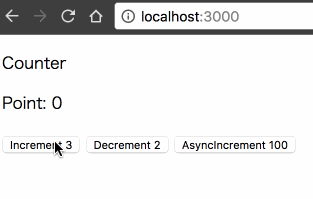概要
前回(Angular入門: Component/ServiceをTestまで含めて試す)の続きです。
今回は
- 通信処理の書き方
- テストの書き方
- 動作確認・デプロイ
を書いていきます。
作った画面
要件としては、前回分に加えて
- AsyncIncrementボタンを押すと、サーバーにデータを取りに行って非同期に数字が加算される。
という形です。
環境
- angular-cli: beta-32
- Angular: 2.4
- NodeJS: 6.9
ソースコードはこちら↓
https://github.com/uryyyyyyy/angularSample/tree/async
前提:APIサーバー
SPAの場合は、フロントのリソースはS3などのホスティングサービスから配信するかもしれません。
その場合はAPIサーバーのエンドポイントは別のホストになることが有り得ます。
本記事ではそのような配信体系を想定して、動作確認用にexpressでAPIサーバーを立てます。
コードはすごくシンプルにこんな感じです。
const express = require('express');
const app = express();
app.get('/api/count', (req, res) => {
res.contentType('application/json');
res.header("Access-Control-Allow-Origin", "*");
const obj = {"num": 100};
setTimeout(() => res.json(obj), 1000);
//res.status(400).json(obj); //for error testing
});
// CORSを許可する
app.use((req, res, next) => {
res.header("Access-Control-Allow-Origin", "*");
res.header("Access-Control-Allow-Headers", "Origin, X-Requested-With, Content-Type, Accept");
next();
});
app.listen(9000, (err) => {
if (err) {
console.log(err);
}
console.log("server start at port 9000")
});
これで、別ホストからのAPI問い合わせに対してもレスポンスを返せるようになります。
(/api/count は後で画面から叩くエンドポイントです。)
Service
src
import {Injectable} from '@angular/core';
import {Http, Headers, Response} from '@angular/http';
import {Observable, BehaviorSubject} from 'rxjs/Rx';
import {environment} from '../../environments/environment';
import {ErrorObservable} from 'rxjs/observable/ErrorObservable';
export const messageEndPoint = `${environment.host}/api/count`;
@Injectable()
export class CounterService {
point: BehaviorSubject<number> = new BehaviorSubject(0);
//①
headers: Headers = new Headers({
'Content-Type': 'application/json',
'Accept': 'application/json',
'X-Requested-With': 'XMLHttpRequest'
});
constructor(private http: Http) { }
/* ... */
//②
fetchNumber(): Observable<{num: number}> {
return this.http.get(messageEndPoint, {headers: this.headers})
.map(res => {
if (res.status === 200) {
return res.json();
} else {
throw new Error(`response.status is bad: ${res.status}`);
}
}).catch(err => this.handleError(err));
}
//③
private handleError(error: Response | any): ErrorObservable<string> {
let errMsg: string;
if (error instanceof Response) {
const body = error.json() || '';
const err = body.error || JSON.stringify(body);
errMsg = `${error.status} - ${error.statusText || ''} ${err}`;
} else {
errMsg = error.message ? error.message : error.toString();
}
// console.error(errMsg);
return Observable.throw(errMsg);
}
//④
asyncIncrement(): Observable<{num: number}> {
return this.fetchNumber()
.do((obj: {num: number}) => this.point.next(this.point.getValue() + obj.num));
}
}
今回はServiceの中で通信処理を行うので、HttpモジュールをDIしています。
画面から叩くメソッドは④の asyncIncrement です。ここでは、②の fetchNumber() から来たStreamの中で副作用を用いて状態を更新して、呼び出し元(画面側)にStreamを返しているだけです。(ちなみに、状態の更新は最新の値を元に行われるので、race conditionの心配はありません。)
②では、通信を行って結果の成否で処理を振り分けています。失敗時には③の handleError というところで良い感じにエラーメッセージを作っています。
ちなみに、①でheaderを指定してあげてサーバーでも対応することで、CSRFを(ほとんどの場合)防ぐことができます。
test
import {BaseRequestOptions, Http, Response, ResponseOptions} from '@angular/http';
import {MockBackend, MockConnection} from '@angular/http/testing';
import {CounterService, messageEndPoint} from './counter.service';
import {Observable} from 'rxjs/Rx';
describe('CounterService', () => {
const defaultOptions = new BaseRequestOptions();
//①
it('asyncIncrement() should query url', () => {
const httpMock: any = {get: () => null};
spyOn(httpMock, 'get').and.returnValue(Observable.of());
const service = new CounterService(httpMock);
service.fetchNumber().subscribe();
expect(httpMock.get).toHaveBeenCalledTimes(1);
expect(httpMock.get).toHaveBeenCalledWith(messageEndPoint, jasmine.any(Object));
});
//②
it('asyncIncrement() should increase point', () => {
const backend = new MockBackend();
const service = new CounterService(new Http(backend, defaultOptions));
backend.connections.subscribe((connection: MockConnection) => {
connection.mockRespond(new Response(new ResponseOptions({
status: 200,
body: JSON.stringify({num: 100})
})));
});
expect(service.point.getValue()).toBe(0);
service.asyncIncrement().subscribe();
expect(service.point.getValue()).toBe(100);
});
//③
it('asyncIncrement() should fail with bad response', () => {
const backend = new MockBackend();
const service = new CounterService(new Http(backend, defaultOptions));
backend.connections.subscribe((connection: MockConnection) => {
connection.mockRespond(new Response(new ResponseOptions({
status: 400,
body: JSON.stringify({error: 'WTF'})
})));
});
service.asyncIncrement().subscribe(null, (err: string) => {
expect(err).toBe(`response.status is bad: 400`);
});
});
});
ここでは3つのテストを行っています。
①では、通信処理を行うときに正しいURLに問い合わせていることの確認をします。
②では、通信処理の成功時に状態が正しく変わることの確認をします。
ここは少々特殊で、AngularのHttpモジュールは内部にBackendというものを持っていて、実質ここで通信処理が行われます。Angularではここのテスト用にMockBackendというオブジェクトを用意していて、MockBackendにconnectionが要求された時にダミーのレスポンスが返るように設定することができます。
こうすることで、 http.get が任意のレスポンスを返すようにし、色々な挙動のテストをすることができるのです。(ぶっちゃけAngularのHttpモジュールめんどくさいのですが、Angular wayに乗っかっておきます。)
③では、通信処理の失敗時にSubscriberにエラーを通知できることの確認をします。
先ほど同様でレスポンスに400を返すことで、Subscriberにエラーが渡ってきます。
以上となります。
前回同様、ここはAngularの基盤に依存していないので、あえて自前でDIすることでテストを書いてみました。
Component
src
<p>Counter</p>
<p *ngIf="isLoading()">Loading... Queue: {{loadingCount}}</p>
<p>Point: {{point}}</p>
<button (click)="increment(3)">Increment 3</button>
<button (click)="decrement(2)">Decrement 2</button>
<button (click)="asyncIncrement()">AsyncIncrement 100</button>
import { Component } from '@angular/core';
import {CounterService} from './services/counter.service';
@Component({
selector: 'app-root',
templateUrl: './app.component.html',
styleUrls: ['./app.component.scss']
})
export class AppComponent {
loadingCount = 0; // 複数リクエストが来ることがあるのでboolでなくnumber
/* ... */
async asyncIncrement() {
this.loadingCount ++;
try {
await this.counterService.asyncIncrement().toPromise();
} catch (err) {
console.error(err);
} finally {
this.loadingCount --;
}
}
isLoading(): boolean {
return this.loadingCount !== 0;
}
}
非同期処理である、 asyncIncrement を呼ぶところを追加しています。
ここでは、返り値のObservableを使いやすいようにPromiseに変換して、成否に応じて処理を分岐させています。
また、「loading中を示すぐるぐるするやつ」を表示するための状態である loadingCount を管理させるようにしていて、通信中は「Loading...」の表示がされるようになっています。
test
import {TestBed} from '@angular/core/testing';
import {AppComponent} from './app.component';
import {BehaviorSubject} from 'rxjs/Rx';
import {CounterService} from './services/counter.service';
describe('AppComponent', () => {
/* ... */
//①
it('should call asyncIncrement', () => {
const fixture = TestBed.createComponent(AppComponent);
const service = fixture.debugElement.injector.get(CounterService);
spyOn(service, 'asyncIncrement');
const button = fixture.debugElement.nativeElement.querySelectorAll('button')[2];
button.click();
expect(service.asyncIncrement).toHaveBeenCalledTimes(1);
expect(service.asyncIncrement).toHaveBeenCalledWith();
});
//②
it('should log when asyncIncrement failed', async () => {
const fixture = TestBed.createComponent(AppComponent);
const service = fixture.debugElement.injector.get(CounterService);
spyOn(service, 'asyncIncrement').and.returnValue(Observable.throw('WTF'));
spyOn(console, 'error');
const button = fixture.debugElement.nativeElement.querySelectorAll('button')[2];
await button.click();
expect(console.error).toHaveBeenCalledTimes(1);
expect(console.error).toHaveBeenCalledWith('WTF');
});
});
①は前回と同じで、ボタンを押したらちゃんとServiceの asyncIncrement が呼ばれていることを確認しています。
②は、 asyncIncrement がエラーを返した場合のテストです。この画面ではconsole.errorが呼ばれることになっているのでそれをテストしています。
注意点としては、 asyncIncrement をPromiseとして扱っているため、async/awaitで書いてあげる必要があることです。
動作確認
npm run build
をした後に、
npm run server:static
//別プロセスとして
npm run server:api
でAPIサーバと静的リソース配信サーバを立ち上げて、
localhost:3000で動作確認できます。
デプロイ
APIサーバのエンドポイントは開発時と本番時で違いますよね?
こういう時はAngular CLIで作ったプロジェクトに備わっている environment という仕組みで、本番ビルド時の定数値を書き換えることで実現できます。
import {Environment} from '../main';
export const environment: Environment = {
production: true,
host: 'http://production.example.com'
};
次回はルーティングを扱ってようと思います。
